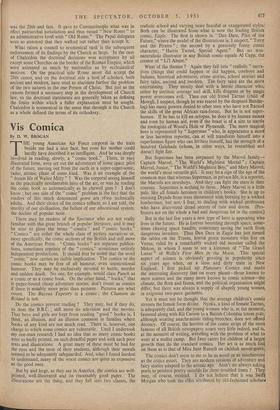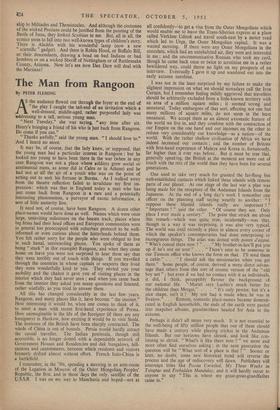Vis Comica
By D. W. BROGAN THE young American Air Force corporal in the train beside me had a nice face, but even his mother could hardly have described it as intelligent. And he was deeply involved in reading, slowly, a "comic book." There, in easy illustrated form, were set out the adventures of some space pilot of the future, moving out from the earth in a super-super-sonic, radar, atomic plane of some kind. Was it an example of the "dream life of Walter Mitty " ? Was the corporal seeing himself as the practically invulnerable hero of the air, or was he reading the comic book as automatically as he chewed gum ? I don't know ; but one side of the " comic " problem is the fact that the readers of this much denounced genre are often technically adults. And their choice of the comics reflects, so I am told, the sterility of our civilisation, the failure of our educational system, the decline of popular taste.
There may be readers of the Spectator who are not really familiar with this great branch of popular literature, and it may be wise to gloss the terms " comics " and `-' comic books.'
" Comics " are either the whole class of picture narratives or, more specifically, the comic sections of the British and still more of the American Press. "Comic books" are separate publica- tions, sometimes reprints of the "comics," sometimes entirely independent productions. It should first be noted that the word " comic " now carries no risible implication. The comics or the comic books may be free of all humour, even unintentional humour. They may be exclusively devoted to battle, murder and sudden death. No one, for example, would class Punch as a comic or as a comic book. On the other hand, "books," that is paper-bound cheap adventure stories, don't count as comics if there is notably more print than pictures. Pictures are what count. The Bayeux Tapestry is a comic ; the Chanson de Roland is not.
Do the comics prevent reading ? They may, but if they do, so does the B.B.C. ; still more do television and the movies.
That boys and girls are-kept from reading " good " books is, I think, an illusion, and an illusion common in families where books of any kind are not much read. There is, however, one charge to which some comics are vulnerable. Until I undertook my one-man research I had no idea that so many comic books were so badly printed, on such dreadful paper and with such poor texts and illustrations. A great many of these must be bad for the eyes and the taste of their students, although their morals seemed to be adequately safeguarded. And, what I found hardest to understand, many of the worst comics are quite as expensive as the good ones.
But by and large, as they say in America, the comics are well- printed, well-illustrated and 'on reasonably good paper. The illustrations are the thing, and they fall into two classes, the realistic school and varying more fanciful or exaggerated stylesJ Both can be illustrated from what is now the leading British comic, Eagle. The first is shown in "Dan Dare, Pilot of the Future," where the model of the illustrations is, I suspect, "Terry and the Pirates " ; the second by a genuinely funny comic character, "Harris Tweed, Special Agent." But no non- naturalistic illustrator in any British comic equals Al Capp, the creator of " Li'l Abner."
What of the themes ? Again they fall into "realistic" narra- tives (things that could happen or did happen, cowboys and Indians, historical adventures, crime stories, school stories) and fairy tales, ancient and modern. The fairy tales are the more .entertaining. They mostly deal with a heroic character who either by intrinsic courage and skill, kills dragons or by magic power overcomes evil. Thus our old friend Tarzan (child of Mowgli, I suspect, though he was reared by the despised Bandar- log) has many powers denied to other men who have not tuned the skills of the great African rain-forest. But he is not super- human. If he has to kill an octopus, he does it by human means and even by human aid, even if the beast is of a size to startle the zoologists of Wood's Hole or Plymouth. The more magicali hero is represented by " Superman ' who, in appearance a more or less harmless reporter, can at will transform himself into al superhuman figure who can levitate himself, has the strength of a' hundred Galahads (whom, in other ways, he resembles) and doesn't fight fair.
But Superman has been surpassed by the Marvel family— Captain Marvel, "The World's Mightiest Mortal " ; Captain Marvel, Junior, " The World's Mightiest Boy," and Mary Marvel, the world's most versatile girl. It may be a sign of the age of the common man that whereas Superman, in private life, is a reporter. the Marvels are newsboys. And they can fight the stars in their courses. Superman is nothing to them. Mary Marvel is a little pale, like all female heroines in children's books. She is up to rescuing Dryads from trees threatened with burning by a wicked lumberman, but not; I fear, to dealing with wicked professors who have discovered dread secrets of ruin and doom. (Pro- fessors are on the whole a bad and dangerous lot in the comics.) But in the last few years a new type of hero is appearing who lives in the future. He is forever bounding through space, some- times chasing space bandits, sometimes saving the earth from dangerous invaders. Thus Dan Dare in Eagle has just turned the tables on the Treens, horrid green monsters who live on Venus, ruled by a remarkably wicked old monster called the Mekon, in whom I seem to see a kinsman of "The Grand Lunar" of Wells's First Men in the Moon. This special aspect of science is obviously growing in popularity since six years ago when, on a slow and dirty train in New England, I first picked up Planetary Comics and made the interesting discovery that on every planet—those known to mere science and the many more known to comic science—the climate, the flora and fauna, and the political organisation might differ, but there was always a supply of shapely young women, in exiguous two-piece garments.
Yet it must not be thought that the average children's comic stresses the female form divine. Nyoka, a kind of female Tarzati, is adequately clad, and the young woman who is, at the moment, fastened along with Kit Carson to a Buitish Columbia totem pole,' .although wearing anachronistic riding-breeches, does not offend decency. Of course, the heroine of the comic strips of the most famous of all British newspapers wears very little indeed, and is, at the moment of writing, wrestling with the problem of what to wear at a nudist camp. But Jane caters for children of a larger growth than do the standard comics. Her art is as much los( on them as is that of Miss Jane Russell on childish movie-goers.1 The comics don't seem to me to be as novel or as mischievous as the critics assert. They are modern versions of adventure and fairy stories adapted to the atomic age. Aren't we always askinii, poets to produce poetry suitable for these troubled tunes ? They may, of course, mislead. I do not believe that it was Swift Morgan who took the roles attributed by old-fashioned scholani thip to Miltiades and Themistodes. And although the costumes of the wicked Persians could be justified from the painting of the Battle of Issus, they looked Scythian to me. But, all in all, the comics seem to fall into two well-known types of children's story. There is Aladdin with his wonderful lamp (now a new " scientific " gadget). And there is Robin Hood, or Buffalo Bill, or their descendants, drawing a bead on bad Indians or bad hombres or on a wicked Sheriff of Nottingham or of Rattlesnake County, Arizona. Now let's see how Dan Dare will deal with the Martians!






















































 Previous page
Previous page